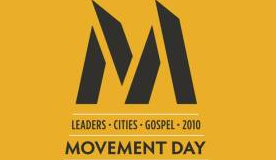 On September 30th, in New York City, several organizations are hosting “a gathering of leaders to catalyze Gospel Movements in their cities.” It’s called Movement Day. I’m hoping to be there. Tim Keller, Bill Hybels, Brenda Salter McNeil and Ray Bakke will lead plenary sessions. The exploration of “Movements” continues to inspire greater understanding of Gospel-driven change while helping develop innovative approaches to that end.
On September 30th, in New York City, several organizations are hosting “a gathering of leaders to catalyze Gospel Movements in their cities.” It’s called Movement Day. I’m hoping to be there. Tim Keller, Bill Hybels, Brenda Salter McNeil and Ray Bakke will lead plenary sessions. The exploration of “Movements” continues to inspire greater understanding of Gospel-driven change while helping develop innovative approaches to that end.
In a recent article, Tim Keller talked about movements–illustrating some of the clear thinking going on around the concept of movements. Read the full article, but here are some highlights as Tim compares the vital dynamic in movements with its lack in institutional approaches to change.
- A movement is marked by an attractive, clear, unifying vision for the future together with a strong set of values or beliefs. The content of the vision must be compelling and clear so that others can grasp it readily.Such visions lead to sacrificial commitment by everybody involved. Individuals put the vision ahead of their own interests and comfort. Keller argues that “there is no more practical index of whether you have a movement or not. If the leader is making all the sacrifices, you don’t.”In contrast, “institutionalized” organizations are held together by rules, regulations, and procedures, not by a shared vision.
- Vision-marked movements experience a generous flexibility. “The accomplishment of the vision is more important than power and position; everyone is willing to make allies, be flexible, and cooperate with anyone sharing the basic vision and values.”In contrast, institutionalized organizations are very turf conscious. “Members are suspicious of anyone encroaching on their area of responsibility. Positions and power have been hard-won and jealously guarded.”
- Vision-marked movements are innovative. Unified and empowered by commonly shared vision, movements are “flatter” by nature and thus ideas “flow out of the whole organization, top to bottom, bottom to top.” Anyone with a good idea about how to accomplish the vision is welcome to give it.In contrast, Institutions are organized more vertically, where ideas from “below” are unwelcome.
- Finally, a movement is marked by spontaneous generativity. Keller writes, “spontaneous combustion means energy generated from within — a conflagration without the need for external ignition. A movement is able to generate its own resources, recruit its own new members and participants, and (especially) raise up its own new leaders.”In contrast, institutions devoid of vision must recruit staff raised up in other environments and attract them mainly with good compensation.
Keller quotes David Hurst, a Harvard scholar, who summed up how movements become institutions:
vision becomes strategy,
roles become tasks,
networks become organizations,
recognition becomes compensation.
Keller warns, however, that we must not get the impression “that all authority, central control, and formal processes are bad for ministry. The reality is more complex.”
As time goes on, to maintain the main engine of movement-dynamics – a unified vision — a ministry must adopt some of the aspects of institutions. A strong movement, then, occupies the difficult space between being a free-wheeling organism and a disciplined organization. A movement that refuses to take on some organizational characteristics – authority, tradition, unity of belief, and quality control — will fragment and dissipate. A movement that does not also resist the inevitable tendency toward complete institutionalization will lose its vitality and effectiveness as well. The job of the movement leader is to steer the ship safely between these two opposite perils.
Dr. Tim Keller is the Senior Pastor of Redeemer Presbyterian Church (PCA) in Manhattan, NY and a Council member with The Gospel Coalition. For more resources by Tim Keller visit Redeemer City to City.
Leave a Reply